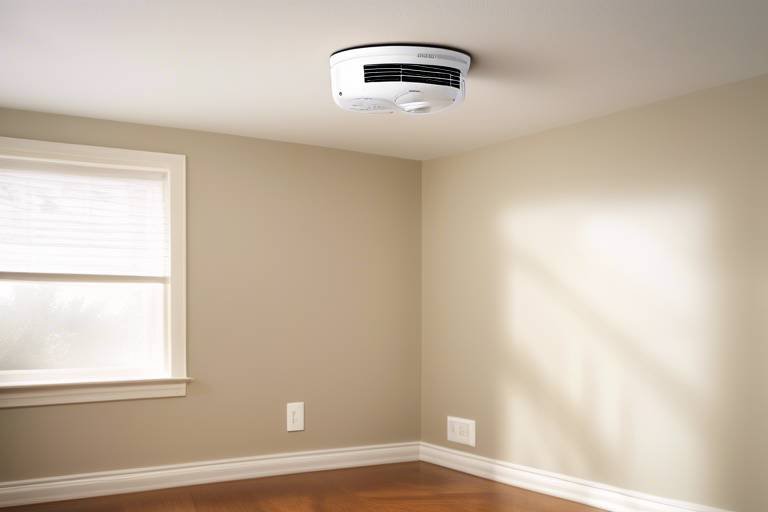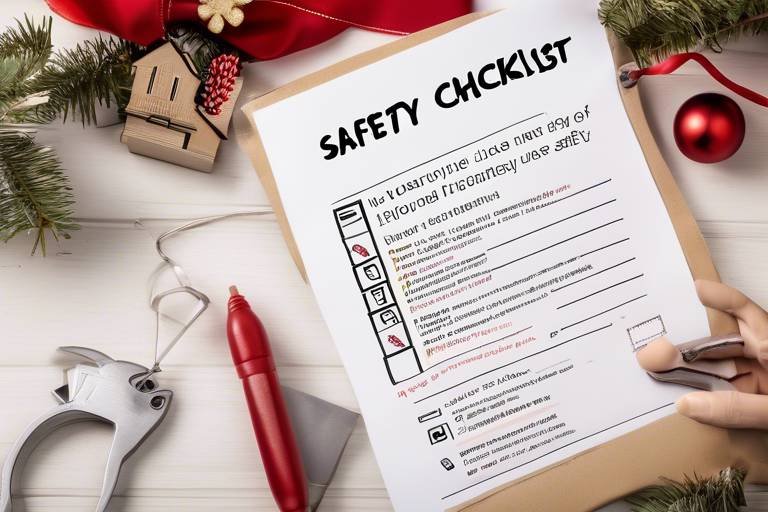Safety Tips to Follow When Moving Houses
Moving houses can be an exhilarating yet daunting task. It's like embarking on a new adventure, but with the potential for chaos lurking around every corner. To ensure that your moving experience is not only smooth but also safe, it's essential to pay attention to certain safety tips. Whether you're a seasoned mover or a first-timer, having a plan can make all the difference. This article will guide you through the necessary precautions and strategies to protect yourself and your belongings during the moving process.
First things first, planning your move is crucial. Imagine trying to navigate a maze without a map—confusing, right? A detailed moving checklist and timeline can act as your roadmap, helping you to keep track of everything from packing to transportation. By breaking down the tasks into manageable chunks, you can minimize stress and ensure that no aspect of your move is overlooked. Start by creating a list of all the items you need to pack, and don't forget to include important documents and essentials that you'll need right away.
Next, let's talk about choosing the right moving company. This decision can significantly impact your moving experience. A reputable moving company prioritizes safety and reliability, so it's essential to do your homework. Start by checking their credentials, which includes verifying their license and insurance. You wouldn’t want to hand over your cherished belongings to just anyone, right? Also, take the time to read customer reviews on multiple platforms. This will give you a balanced perspective on the company's reliability and professionalism.
When it comes to evaluating moving companies, obtaining quotes is another critical step. Getting estimates from multiple companies allows you to compare services and costs effectively. Make sure to request detailed quotes that outline what services are included. This way, you won’t be caught off guard by hidden fees later on. Remember, the goal is to find a company that not only fits your budget but also meets your safety standards.
Understanding moving insurance is another vital aspect of a safe move. Moving insurance protects your belongings during transit, giving you peace of mind. There are various types of coverage available, from basic liability to full-value protection. Assess your needs and choose the best option for your situation. Think of it as a safety net; you hope you won’t need it, but it’s always better to be prepared.
Now, let’s shift gears to preparing your belongings for the move. Properly packing your items is essential for safety. Investing in quality packing materials can prevent damage during transit. Think of sturdy boxes, strong tape, and ample padding as your protective gear. Just like an athlete wouldn’t step onto the field without proper equipment, you shouldn’t move without the right supplies. Additionally, labeling boxes effectively is crucial. It not only helps you stay organized during the move but also protects fragile items from being mishandled. Make sure to clearly mark which boxes contain delicate items and which are for specific rooms in your new home.
On moving day, prioritizing safety is paramount. You’ll be busy, and it’s easy to overlook safety measures. Using proper lifting techniques is one way to protect yourself from injury. Always bend at your knees and keep your back straight when lifting heavy objects. If something feels too heavy or awkward, don’t hesitate to ask for help. Remember, it’s better to be safe than sorry!
Lastly, don’t forget to stay hydrated and take breaks during the moving process. Moving can be physically demanding, and your body needs fuel to keep going. Think of it like running a marathon; you wouldn’t sprint the whole way without stopping for water, would you? Make sure to drink plenty of water and schedule short breaks to recharge your energy and focus. This will not only help you stay alert but also ensure that you’re in the best shape to tackle the day’s challenges.
Q: What should I do if I can't lift heavy items?
A: If you find yourself struggling with heavy items, it's best to ask for help or hire professional movers who are trained to handle such tasks safely.
Q: How can I ensure my belongings are safe during the move?
A: Use quality packing materials, label boxes effectively, and consider purchasing moving insurance for added protection.
Q: What are the best packing materials to use?
A: Sturdy boxes, bubble wrap, packing paper, and strong tape are essential for protecting your items during the move.
Q: How can I find a reputable moving company?
A: Research online, check reviews, verify credentials, and obtain quotes from multiple companies to make an informed decision.

Planning Your Move
Effective planning is crucial for a safe move. Think of moving as a grand adventure, where the journey is just as important as the destination. You wouldn’t set off on a road trip without a map, right? Similarly, creating a detailed moving checklist and timeline is essential to minimize stress and ensure all aspects are considered. Start by making a comprehensive list of everything you need to do before the big day. This could include tasks like sorting through your belongings, deciding what to keep or discard, and scheduling utilities at your new home.
As you draft your checklist, break it down into manageable sections. You might want to categorize tasks into weeks leading up to the move. For instance, in the first week, focus on decluttering your space. Ask yourself: What do I really need? This can help lighten your load both physically and mentally. In the following weeks, you can tackle packing, notifying your change of address, and arranging transportation. Here’s a simple table to illustrate a potential timeline:
| Week | Tasks |
|---|---|
| 4 Weeks Before | Declutter and donate unwanted items |
| 3 Weeks Before | Start packing non-essential items |
| 2 Weeks Before | Notify change of address and schedule utilities |
| 1 Week Before | Pack essentials and confirm moving arrangements |
| Moving Day | Conduct a final walkthrough and move! |
Don't forget to communicate with everyone involved in the move, whether it's family members, friends, or hired movers. Keeping everyone on the same page can prevent last-minute chaos and ensure that all hands are on deck when the time comes. Consider creating a group chat or a shared document to keep track of responsibilities and updates.
Finally, remember that flexibility is key. No matter how well you plan, things can go awry. A moving truck might be late, or an unexpected rain shower could dampen your day. Stay calm and adaptable; after all, it’s just part of the adventure! With a solid plan in place, you’ll not only ensure a smoother transition but also allow yourself to enjoy the excitement of moving into a new home.
Here are some common questions people have when planning their move:
- How far in advance should I start planning my move? Ideally, start planning at least four to six weeks before your moving date.
- What should I do with items I no longer need? Consider donating, selling, or recycling items to lighten your load.
- How can I keep track of my moving checklist? Use a digital tool or app to manage your tasks and deadlines effectively.

Choosing the Right Moving Company
When it comes to moving houses, one of the most critical decisions you'll make is . This choice can significantly influence not only the efficiency of your move but also the safety of your belongings. Imagine entrusting your precious items to a team that doesn’t prioritize care or reliability. It’s a nightmare waiting to happen! To avoid such scenarios, you need to be thorough in your research and evaluation.
Start by researching potential moving companies. Check out their websites, look for customer testimonials, and see if they have a solid online presence. A reputable company will often showcase their expertise and customer satisfaction prominently. Don’t just stop at the first company that pops up on your search engine; take the time to explore multiple options. You wouldn’t buy the first car you see, right? The same principle applies here.
Next, assess their credentials. This involves verifying that the moving company is licensed and insured. A licensed company adheres to industry standards, which is crucial for your peace of mind. You can usually find this information on their website or by asking directly. If they hesitate to provide proof of their credentials, consider that a red flag. Additionally, check their insurance options. Moving insurance is vital because it protects your belongings during transit. You wouldn’t drive a car without insurance, so why risk your valuables?
Before you sign any contracts, make sure to check the company's credentials. This includes looking for their licensing information, insurance details, and any affiliations with professional moving organizations. A trustworthy company will be transparent about their credentials and happy to provide documentation. If they seem evasive, it might be best to keep searching.
Customer reviews are a treasure trove of information when evaluating a moving company. They can provide insights into the experiences of others, helping you gauge reliability and performance. Be sure to read reviews across multiple platforms, such as Google, Yelp, and social media. This will give you a well-rounded view of the company’s reputation. Look for patterns in the feedback—if multiple customers mention the same issue, it’s likely a valid concern. Remember, a few negative reviews among many positive ones can be normal, but consistent complaints should raise alarms.
Once you’ve narrowed down your options, it’s time to obtain quotes from the companies you’re considering. Reach out to at least three different movers to compare their services and prices. When requesting quotes, be sure to provide as much detail as possible about your move, including the size of your home, the distance of the move, and any special items that require extra care. This will help ensure you receive accurate estimates. Keep an eye out for hidden fees and be wary of quotes that seem too good to be true; if a price is significantly lower than others, it might indicate a lack of quality or service.
In summary, choosing the right moving company is not just about picking the first name you see on Google. It requires careful consideration and thorough research. By checking credentials, reading reviews, and obtaining quotes, you can ensure that you select a company that will handle your move safely and efficiently. Remember, this is your life and belongings at stake, so take the time to make an informed decision.
- How do I know if a moving company is reputable? Look for licensing, insurance, and read customer reviews.
- What should I ask when getting a quote? Inquire about all costs, including potential hidden fees, services offered, and insurance options.
- Is moving insurance necessary? Yes, it protects your belongings during transit and offers peace of mind.

Checking Credentials
When it comes to hiring a moving company, is not just a good idea; it's essential for ensuring a secure and stress-free moving experience. Imagine handing over your prized possessions to a stranger without knowing anything about them—sounds risky, right? To avoid this nightmare scenario, you should take the time to verify the credentials of any moving company you're considering. This process involves several key steps that can help you gauge the reliability and professionalism of the movers.
First off, begin by checking if the moving company has the necessary licenses to operate in your state. Most states require moving companies to have a valid license issued by the Department of Transportation (DOT). You can easily check this information online. Additionally, make sure the company has insurance coverage. This is crucial because it protects your belongings in case of damage or loss during the move. A reputable company will gladly provide proof of insurance upon request.
Furthermore, don’t overlook the importance of customer reviews. They can provide a wealth of information about the company’s reliability and quality of service. Look for reviews on multiple platforms, such as Google, Yelp, and the Better Business Bureau (BBB). This will give you a more balanced view of the company. Pay attention to patterns in the reviews; if multiple customers mention similar issues, it's a red flag. On the flip side, glowing reviews can give you confidence in your choice.
Another aspect to consider is whether the moving company is a member of any professional organizations, such as the American Moving and Storage Association (AMSA). Membership in such organizations often indicates adherence to industry standards and a commitment to ethical practices. You can usually find this information on the company’s website or by asking them directly.
In summary, checking the credentials of a moving company involves:
- Verifying their license and insurance.
- Reading customer reviews on various platforms.
- Checking for membership in professional organizations.
By taking these steps, you can ensure that you're entrusting your valuable belongings to a reputable moving company, making your move a whole lot smoother and safer.
1. How can I verify a moving company's license?
You can verify a moving company's license by visiting your state's Department of Transportation website, where you can search for licensed movers.
2. What should I do if a moving company doesn't have insurance?
If a moving company does not have insurance, it is advisable to look for another company. Insurance protects your belongings during the move, and working with an uninsured company can put your items at risk.
3. How important are customer reviews?
Customer reviews are extremely important as they provide insights into the experiences of others who have used the service. They can help you identify potential issues and gauge the overall reliability of the company.
4. What if I find negative reviews?
If you come across negative reviews, take them seriously. Look for patterns in the complaints and consider whether the issues raised are deal-breakers for you. It might be worth seeking out other options.

Reading Reviews
When it comes to choosing a moving company, can be your secret weapon. Think of it as peering into a crystal ball that reveals the experiences of others who have walked the same path. Reviews can provide you with a wealth of information about a company's reliability, professionalism, and overall service quality. But how do you sift through the noise to find the gems? Start by checking multiple platforms. Websites like Yelp, Google Reviews, and even social media pages can offer varied insights. Each platform may attract different types of customers, which can lead to a more rounded view of the company.
As you read through the reviews, look for patterns. Are customers consistently praising the same aspects of the service? For instance, if multiple reviews highlight the punctuality of the movers or their careful handling of fragile items, you might be onto a reliable choice. Conversely, if you notice a trend of complaints—like delays or damaged goods—it might be a red flag worth considering. Don't forget to pay attention to the dates of the reviews as well. A flurry of positive reviews from a few years ago might not reflect the current state of the company.
Additionally, be cautious of overly positive reviews that seem too good to be true. Sometimes, companies may post fake reviews to boost their ratings. To combat this, look for reviews that are detailed and provide specific examples of the service received. A review that simply states, "They were great!" lacks the depth needed to make an informed decision. Instead, a review that describes how the movers handled a particularly challenging staircase or how they went above and beyond to accommodate a last-minute request is far more valuable.
In summary, reading reviews is not just about tallying up stars; it’s about understanding the nuances of a company's service. By diving deep into customer feedback, you can make a more informed decision that could save you time, money, and stress during your move. Remember, a well-informed choice can lead to a smoother moving experience, allowing you to focus on settling into your new home rather than worrying about the logistics of the move.
- How can I find trustworthy moving company reviews? Look at multiple review platforms such as Google Reviews, Yelp, and Facebook. Pay attention to the overall sentiment and specific details.
- What should I do if I find negative reviews? Consider the context of the reviews. Look for patterns and see if the company has responded to complaints, which can indicate how they handle issues.
- Are all reviews reliable? Not all reviews are created equal. Be wary of overly positive or vague reviews, and focus on those that provide specific details.

Obtaining Quotes
When it comes to moving, obtaining quotes from various moving companies is not just a good idea—it's a crucial step in ensuring you get the best service for your budget. Think of it as shopping for a new car; you wouldn’t just walk into the first dealership and make a purchase without comparing prices and features, right? Similarly, gathering multiple quotes allows you to assess the value of services offered and helps you avoid any potential pitfalls.
To start the process, reach out to at least three different moving companies. Be prepared to provide them with essential details about your move, such as the size of your home, the distance between locations, and any special items that require extra care. This information will help the movers give you a more accurate estimate. While some companies may offer ballpark figures over the phone, it’s advisable to request an in-home assessment for a precise quote. This way, the movers can evaluate your belongings firsthand and consider any unique challenges that may arise.
When you receive the quotes, don't just focus on the bottom line. Instead, examine the breakdown of services included in each estimate. Here’s a handy table to illustrate what to look for:
| Company | Base Price | Services Included | Additional Fees |
|---|---|---|---|
| Company A | $800 | Loading, Unloading, Packing Materials | $100 (Fuel surcharge) |
| Company B | $950 | Loading, Unloading, Packing, Insurance | $50 (Tolls) |
| Company C | $700 | Loading, Unloading | $200 (Packing materials extra) |
As you can see, the base price isn't the only factor; the services included and any additional fees can significantly impact the total cost. Once you have all this information, it’s time to weigh your options. Ask yourself: What services do you truly need? Are you willing to pay a little more for added convenience? Or do you prefer to save money and handle some tasks yourself?
Lastly, don't hesitate to negotiate. If you find a better quote with similar services, share that information with the other companies. Many movers are willing to match or beat competitors' prices to secure your business. Just remember, the goal is to find a moving company that not only fits your budget but also prioritizes safety and reliability. After all, your belongings deserve the best care possible during this transition!

Understanding Moving Insurance
When it comes to moving, one of the most crucial aspects that often gets overlooked is moving insurance. Imagine this: you've packed up your entire life into boxes, loaded them onto a truck, and then, somewhere along the way, disaster strikes. A box slips, a piece of furniture gets scratched, or, heaven forbid, something valuable breaks. That’s where moving insurance steps in to save the day! It acts as a safety net, ensuring that your belongings are covered during transit, giving you peace of mind in an otherwise chaotic time.
There are typically two types of moving insurance that you should be aware of: basic coverage and full-value protection. Basic coverage is often included at no extra cost, but it only covers a minimal amount per pound of your belongings. This means that if you have a heavy box filled with books, you might only be compensated for a fraction of its value if it gets damaged. On the other hand, full-value protection provides a more comprehensive safety net. If an item is lost or damaged, the moving company is obligated to either repair it, replace it, or reimburse you for its current market value. This option offers a sense of security, especially for those with valuable or sentimental items.
Before you decide on the type of coverage, it’s essential to evaluate your belongings. Take a moment to consider:
- What items are irreplaceable or hold significant value?
- Are there any high-value items that may require additional coverage?
- What is the total estimated value of all your belongings?
Once you have a clear picture of what you need, it’s time to discuss options with your moving company. Don’t hesitate to ask questions about the insurance policies they offer. For instance, inquire about:
- The specifics of what is covered and what isn’t
- Any deductibles that may apply
- How to file a claim if something goes wrong
Understanding these details can make a significant difference in your moving experience. Additionally, some homeowners' or renters' insurance policies may cover moving-related damages, so it’s worth checking with your insurance provider as well. They might have options that work in conjunction with the moving company’s policies, potentially saving you money while still providing comprehensive coverage.
In summary, moving insurance is not just an afterthought; it’s a fundamental part of the moving process that can protect you from unexpected losses. By taking the time to understand your options and making informed decisions, you can ensure that your move is not only smooth but also safe for your cherished belongings.
Here are some common questions people have about moving insurance:
- Do I really need moving insurance? - While it's not mandatory, having insurance can save you from significant financial loss.
- What happens if my items are damaged during the move? - If you have coverage, you can file a claim with the moving company for compensation.
- Is basic coverage enough for my move? - It depends on the value of your belongings; full-value protection is recommended for high-value items.

Preparing Your Belongings
When it comes to moving, is a vital step that can make or break your experience. Imagine trying to fit a square peg into a round hole; that’s what it feels like when you haven’t packed properly! To ensure a smooth transition to your new home, you need to adopt effective packing techniques and use the right materials. This is not just about throwing things into boxes; it’s about safeguarding your cherished items and making the unpacking process a breeze.
First and foremost, investing in quality packing materials is essential. Think of it as wrapping your items in a protective cocoon. Using sturdy boxes, reliable tape, and adequate padding can significantly reduce the risk of damage during transit. For instance, if you have fragile items like glassware or electronics, consider using bubble wrap or packing paper. Not only does this provide cushioning, but it also minimizes movement within the box. Here’s a quick table to give you an idea of what materials work best for different types of items:
| Item Type | Recommended Packing Material |
|---|---|
| Fragile Items | Bubble Wrap, Packing Paper |
| Books | Sturdy Boxes, Packing Tape |
| Clothes | Wardrobe Boxes, Vacuum Bags |
| Electronics | Original Boxes, Foam Padding |
Once you have your materials ready, the next step is to focus on labeling boxes effectively. Picture this: you’ve just moved into your new home, and you’re staring at a mountain of unmarked boxes. It’s overwhelming, right? To avoid this chaos, make it a habit to label each box with its contents and the room it belongs to. This simple act saves you time and energy when you’re unpacking. You can even use color-coded labels for different rooms to make the process even smoother. For example:
- Red: Kitchen
- Blue: Living Room
- Green: Bedrooms
- Yellow: Bathroom
Moreover, don’t forget to mark boxes that contain fragile items with a clear “FRAGILE” label. This not only alerts you but also anyone helping you move to handle those boxes with extra care. Additionally, as you pack, consider the order in which you’ll need items upon arriving at your new place. Essentials should be packed last and easily accessible, while items you won’t need immediately can go in first.
Lastly, as you prepare your belongings, take this opportunity to declutter. Moving is the perfect time to assess what you really need and what can be donated or discarded. It’s like spring cleaning but on a grand scale! By reducing the number of items you move, you not only save time and effort but also lighten your load—both physically and emotionally. So, go ahead and ask yourself: Do I really need this? If the answer is no, let it go!
Q: What materials should I use for packing fragile items?
A: Use bubble wrap, packing paper, and sturdy boxes. Make sure to cushion items well and label them as fragile.
Q: How can I ensure my boxes are organized?
A: Label each box with its contents and the room it belongs to. Consider using color-coded labels for easier identification.
Q: Is it necessary to declutter before moving?
A: Absolutely! Decluttering helps reduce the number of items you need to move, saving you time and effort.

Using Quality Packing Materials
When it comes to moving, the packing process is crucial, and using quality packing materials can make all the difference. Imagine trying to transport your favorite heirloom vase in a flimsy cardboard box; it’s a recipe for disaster! Instead, investing in sturdy materials ensures your belongings arrive at your new home safe and sound. So, what should you consider when selecting packing materials? Let’s dive into some essentials.
First off, you’ll want to choose high-quality boxes. Not all boxes are created equal, and opting for those designed specifically for moving can save you from a lot of headaches. Look for boxes that are double-walled for extra strength, especially for heavier items. For lighter items, single-walled boxes will suffice. The sizes of the boxes are also important; using a variety of sizes can help you maximize space and keep your items secure. Here’s a quick guide:
| Box Size | Best For |
|---|---|
| Small | Books, heavy items |
| Medium | Kitchen items, toys |
| Large | Clothes, bedding |
| Extra Large | Lightweight, bulky items |
Next, don’t underestimate the importance of padding materials. Bubble wrap, packing peanuts, and foam sheets are your best friends when it comes to protecting fragile items. Wrap each item carefully, ensuring that there’s enough padding to absorb any shocks during transit. For larger items, consider using blankets or towels as additional cushioning. This not only protects your belongings but can also save you money on packing materials!
Another critical component is packing tape. Make sure you’re using a strong, durable tape that can withstand the rigors of moving. A common mistake is to use insufficient tape; it might hold during packing, but it could fail during transport, leading to a mess. Aim for at least three strips of tape on the bottom of each box and two on the top. Additionally, consider using tape dispensers for ease and efficiency.
Finally, labeling your boxes is essential. Use a permanent marker to clearly mark what’s inside each box, and don’t forget to indicate if any items are fragile. This simple step can save you time and stress when you’re unpacking in your new home. You might even want to color-code your labels based on the room they belong to, creating a visual guide that simplifies the unpacking process.
In summary, investing in quality packing materials is not just a suggestion; it's a necessity for a successful move. By choosing the right boxes, using adequate padding, securing your items with strong tape, and labeling everything properly, you can protect your belongings and make your moving day much smoother. Remember, the goal is to keep your items safe, so don’t skimp on quality!
- What type of boxes should I use for moving? Use sturdy, double-walled boxes for heavy items and a variety of sizes for different belongings.
- How can I protect fragile items? Wrap them in bubble wrap or foam sheets and use plenty of padding in the box.
- Is it necessary to label boxes? Yes, labeling helps you know what’s inside and where each box should go in your new home.
- How much packing tape should I use? Use at least three strips on the bottom and two on the top of each box for maximum security.

Labeling Boxes Effectively
When it comes to moving, labeling your boxes effectively can be a game changer. Picture this: you’ve just arrived at your new home after a long day of hauling boxes, and you’re faced with a mountain of unmarked containers. Frustration sets in as you scramble to find your essentials—like your toothbrush or that favorite coffee mug. To avoid this chaotic scenario, a strategic labeling system can save you time and sanity.
Start by using clear and descriptive labels. Instead of merely writing “kitchen” on a box, consider specifying its contents, such as “kitchen - pots and pans.” This not only helps you locate items quickly but also aids the movers in knowing where to place each box in your new home. You can even color-code your boxes based on the room they belong to. For instance, use blue labels for the kitchen, green for the living room, and red for bedrooms. This visual cue makes it easy to identify where everything goes at a glance.
Another effective technique is to utilize a numbering system. Assign a number to each box and keep a corresponding inventory list. For example, Box 1 contains bathroom essentials, Box 2 has bedroom linens, and so forth. This way, if a box goes missing, you’ll know exactly which one it is. You can even take it a step further by noting any fragile items on the label. A simple “FRAGILE” or “HANDLE WITH CARE” can alert anyone handling the box to treat it delicately.
When it comes to the physical act of labeling, make sure to use a permanent marker or printed labels that are resistant to smudging. It’s also wise to place the labels on multiple sides of the box. This way, no matter how the box is stacked, you’ll still be able to see what’s inside without having to dig through everything. If you’re using tape to seal your boxes, consider writing the labels on the tape itself, creating a neat and organized appearance.
In addition to labeling, consider creating a master list of all your boxes and their contents. This could be a simple spreadsheet or a handwritten list that you keep handy during the move. Here’s a quick example of how you might format this list:
| Box Number | Contents | Room |
|---|---|---|
| 1 | Bathroom essentials | Bathroom |
| 2 | Winter clothes | Bedroom |
| 3 | Cookware | Kitchen |
By following these labeling strategies, you’ll create a seamless transition into your new home. Remember, the goal is to make unpacking as smooth as possible, allowing you to settle in without unnecessary stress. After all, moving should be an exciting new chapter, not a chaotic mess of boxes!
- What should I write on the labels? Be specific about the contents of each box and include the room it belongs to.
- How can I make my labeling system more efficient? Consider using color codes and a numbering system to keep track of your boxes easily.
- What materials are best for labeling? Use permanent markers or printed labels that are resistant to smudging.
- Should I label all sides of the box? Yes, labeling multiple sides helps ensure visibility no matter how the box is stacked.

Safety During the Move
Moving day can feel like a whirlwind, with boxes everywhere and the clock ticking down. It’s easy to get caught up in the excitement (or chaos) of the moment, but **prioritizing safety** is crucial. After all, the last thing you want is to injure yourself or damage your belongings during what should be a thrilling new chapter in your life. So, let’s dive into some key safety measures that will help protect you, your family, and the moving crew.
First and foremost, one of the most effective ways to prevent injuries is to use proper lifting techniques. You might think lifting is just about brute strength, but it’s more of an art form. Bend your knees, keep your back straight, and lift with your legs—not your back. Imagine you’re a weightlifter at the Olympics, ready to lift that gold medal-winning weight. Position yourself close to the object, grip it firmly, and lift smoothly. If the item is too heavy or awkwardly shaped, don’t hesitate to ask for help. Remember, teamwork reduces the risk of injury and speeds up the process.
Another important aspect to consider is the physical demands of moving. It’s easy to overlook your own needs when you’re busy packing and hauling boxes. **Staying hydrated** is vital. Dehydration can sneak up on you, especially if you’re sweating while lugging heavy furniture. Keep a cooler filled with water and encourage everyone to take regular sips throughout the day. Think of it as a pit stop during a marathon; those breaks keep you going strong. Along with hydration, don’t forget to take breaks. Schedule short intervals where everyone can sit down, stretch, and recharge. This will not only help maintain energy levels but also keep everyone’s spirits high.
As you prepare for the move, it’s also wise to create a safe environment. Clear pathways of any obstacles, such as loose rugs or stray toys, that could cause someone to trip. If you have pets or small children, consider arranging for them to be looked after elsewhere during the move. This way, you can focus on the task at hand without worrying about their safety. **Safety first** should be your motto on moving day!
In addition to these practical tips, it’s essential to communicate effectively with your moving crew. If you’ve hired professionals, don’t hesitate to share any concerns you might have regarding heavy items or tricky stairs. They are trained to handle such situations and can provide guidance on how best to proceed. If you’re moving with friends or family, keep the lines of communication open. A simple “Hey, can you grab that end?” can make a world of difference.
Lastly, don’t forget about your belongings. Ensure that fragile items are properly packed and labeled. Use bubble wrap, blankets, or towels to cushion delicate items. It’s like wrapping a gift; you want to make sure it arrives in perfect condition. And while you’re at it, label those boxes clearly. Not only does this help with organization, but it also alerts everyone to handle certain boxes with extra care.
- What is the best way to lift heavy items? Always lift with your legs, keep your back straight, and ask for help if needed.
- How can I stay hydrated during the move? Keep a cooler with water accessible and encourage everyone to take regular breaks to drink.
- Should I move with pets or children around? It’s safer to arrange for them to be elsewhere to avoid accidents and distractions.
- How do I protect fragile items? Use quality packing materials like bubble wrap and label boxes as fragile.

Using Proper Lifting Techniques
When it comes to moving, one of the most critical aspects that often gets overlooked is the way we lift heavy objects. Using proper lifting techniques not only ensures your safety but also protects your belongings from damage. Imagine trying to lift a heavy box without the right form; it’s like trying to carry a water balloon while running—it’s bound to burst! So, let’s delve into some essential techniques that can make your moving day much safer and more efficient.
First and foremost, always start with a solid stance. Stand with your feet shoulder-width apart to create a stable base. This gives you the balance you need when lifting. Bend at your knees, not your back. Your legs are much stronger than your back, so let them do the heavy lifting. Keep your back straight and your head up. This posture not only protects your spine but also allows you to see where you’re going, preventing accidents.
When you grab the object, make sure to get a good grip. Use both hands and ensure you’re holding it close to your body. This reduces the strain on your back and arms. Think of it like hugging a friend; the closer you are, the easier it is to lift them up! If the object is too heavy or awkwardly shaped, don’t hesitate to ask for help. There’s no shame in teamwork, and it can save you from potential injuries.
Here are some key points to remember when lifting:
- Lift with your legs: Your legs are your best friends when it comes to lifting. They are stronger and can handle more weight than your back.
- Keep the load close: Holding the object close to your body minimizes strain and helps maintain balance.
- Move your feet: If you need to turn, don’t twist your body. Instead, pivot on your feet to avoid straining your back.
- Take your time: Rushing can lead to accidents. Slow and steady wins the race!
Additionally, if you're lifting something particularly heavy, consider using tools like dollies or hand trucks. These tools are designed to help you move large items with ease and can significantly reduce the risk of injury. If you don’t have access to these tools, make sure to lift with a partner whenever possible. It’s much easier to lift a heavy couch with a friend than to go solo!
In conclusion, using proper lifting techniques is a game changer during your move. By following these guidelines, you can protect yourself from injuries while ensuring that your belongings arrive at your new home safely. Remember, it’s not just about getting the job done; it’s about doing it safely. So, lift smart and make your moving day a breeze!

Staying Hydrated and Taking Breaks
Moving day can feel like a whirlwind of activity, and amidst all the chaos, it's easy to forget about your own well-being. But let me tell you, staying hydrated and taking regular breaks is crucial not just for your health, but for the overall success of your move. Imagine you're a car on a long road trip; without fuel, you won't get very far. Similarly, without water and rest, you risk running out of steam before the day is over.
As you lift boxes and navigate through your home, your body is working hard, and it can easily become fatigued. To keep your energy levels up and your spirits high, make a point to drink water throughout the day. Here are some tips to help you stay hydrated:
- Keep Water Accessible: Have plenty of water bottles or a large cooler filled with ice water readily available. This way, you won’t have to search for hydration when you’re parched.
- Set a Timer: Consider setting a timer on your phone to remind you to take a sip every 30 minutes. It’s a simple way to ensure you’re consistently hydrating.
- Infuse Your Water: If plain water doesn’t excite you, try infusing it with fruits like lemon, berries, or cucumber for a refreshing twist.
But hydration alone isn’t enough. Your body also needs breaks to recharge. Taking short breaks allows your muscles to relax, your mind to reset, and your energy to replenish. Here’s why breaks are essential:
- Prevents Overexertion: Continuous lifting and moving can lead to injuries. A quick break helps prevent strain on your body.
- Improves Focus: Stepping away for a few minutes can help clear your mind, allowing you to return to the task with renewed focus.
- Encourages Team Bonding: If you have friends helping you, taking a break together can lighten the mood and make the day more enjoyable.
So, how often should you take breaks? A good rule of thumb is to take a break every hour for about 10-15 minutes. Use this time to stretch, hydrate, and grab a quick snack. Eating small, healthy snacks can also provide the necessary fuel to keep you going. Think of snacks like:
- Nuts and dried fruits
- Granola bars
- Veggies with hummus
By prioritizing hydration and breaks, you’re not just caring for your body; you’re setting yourself up for a successful moving experience. Remember, moving is a marathon, not a sprint. Pace yourself, and you’ll find that the day can be both productive and enjoyable!
Q: How much water should I drink on moving day?
A: Aim for at least 8-10 cups of water throughout the day, but listen to your body and drink more if you feel thirsty.
Q: What are some quick snacks I can prepare for moving day?
A: Consider packing easy-to-eat snacks like granola bars, fruit, or trail mix. They’re portable and provide quick energy!
Q: How often should I take breaks while moving?
A: A good practice is to take a 10-15 minute break every hour. This will help you stay refreshed and focused.
Frequently Asked Questions
- What should I include in my moving checklist?
Your moving checklist should include tasks like scheduling your moving date, researching moving companies, creating an inventory of your belongings, packing strategies, notifying utilities and change of address, and ensuring you have all necessary supplies. Think of it as your roadmap to a smooth move!
- How do I choose a reliable moving company?
Start by researching local moving companies online. Look for reviews on multiple platforms and check their credentials, like licenses and insurance. It's also a good idea to get quotes from at least three companies to compare services and prices. Remember, it’s not just about the cost; consider their reputation and customer service!
- What types of moving insurance are available?
Moving insurance typically comes in two types: released value protection and full value protection. Released value protection is free but offers minimal coverage, while full value protection is more comprehensive and usually comes at an additional cost. Assess your belongings' value and choose the option that best fits your needs.
- How can I pack fragile items safely?
When packing fragile items, use plenty of padding materials like bubble wrap or packing paper. Place these items in sturdy boxes and clearly label them as "fragile." It's also wise to fill any empty spaces in the box to prevent movement during transit. Treat your fragile items like precious treasures; they deserve extra care!
- What are some proper lifting techniques?
To lift heavy objects safely, bend at your knees, not your back, and keep the object close to your body. Use your legs to lift, and avoid twisting your torso while carrying. If the item is too heavy, don’t hesitate to ask for help. Remember, it’s better to be safe than sorry!
- How important is it to stay hydrated during the move?
Staying hydrated is crucial when moving because it keeps your energy levels up and helps you focus. Plan to take regular breaks and drink water throughout the day. Think of hydration as fuel for your moving marathon; without it, you might hit a wall!



















